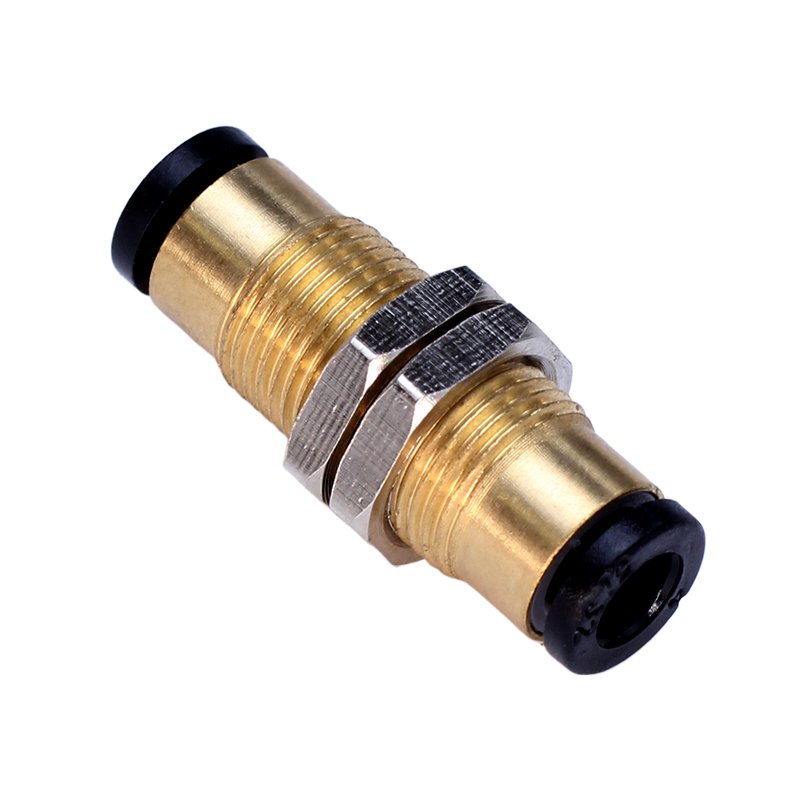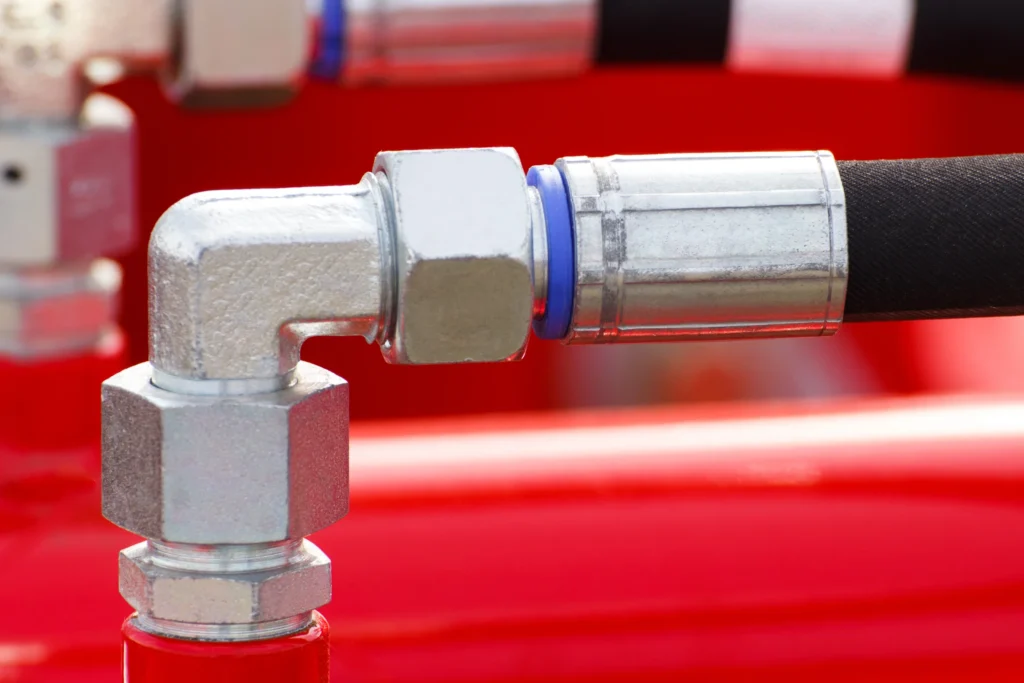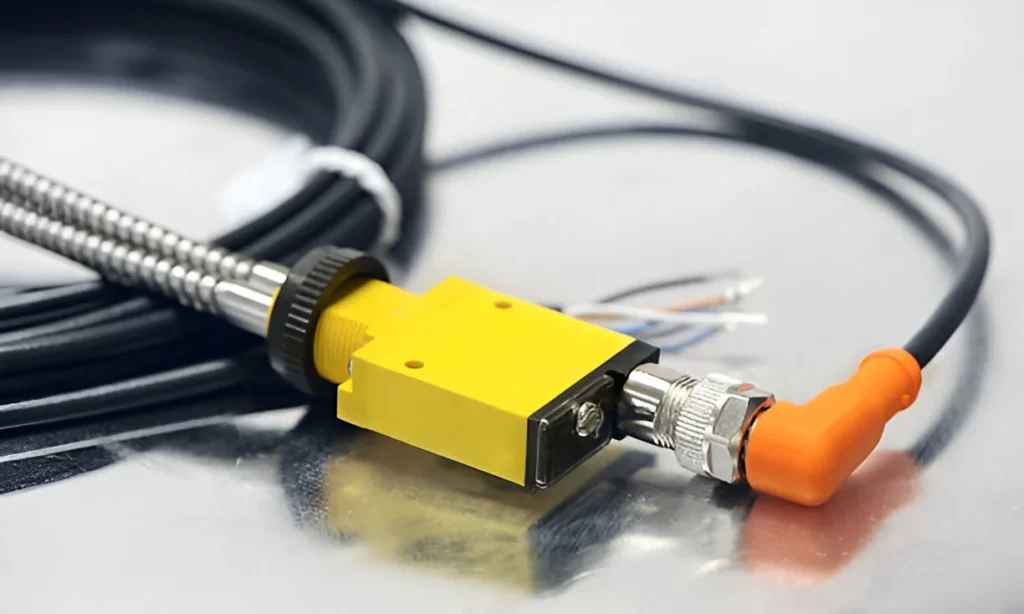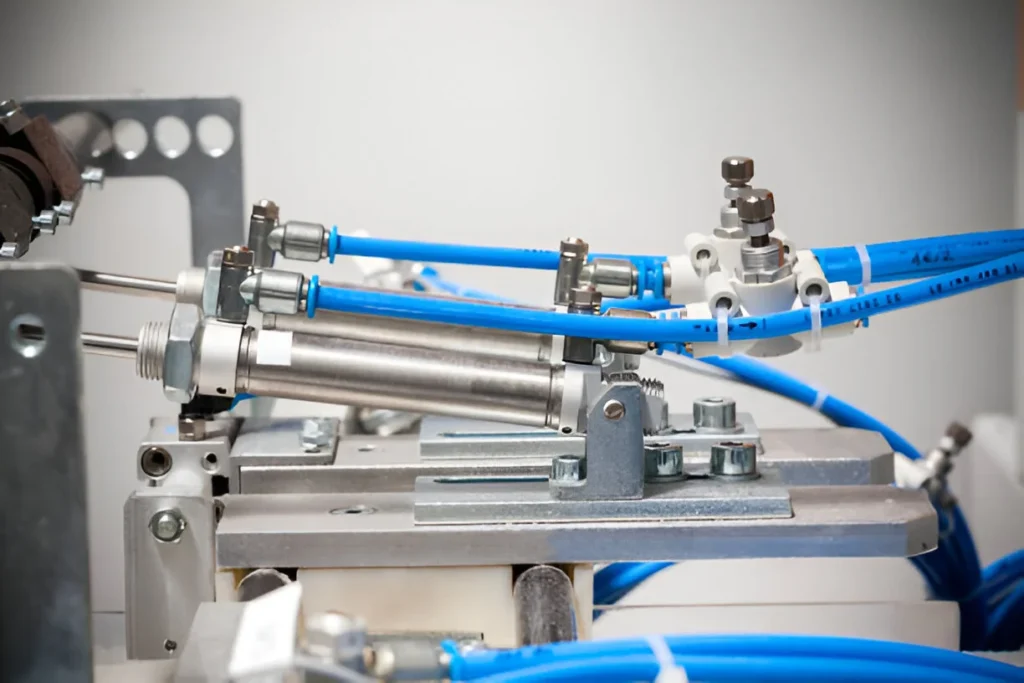The concept of mini cylinder and its application areas
Mini cylinder, a small and compact pneumatic actuator, is widely used in the field of automation technology. It uses compressed air to produce linear or rotational motion to drive various mechanical devices. Due to its small size and light weight, mini cylinders are particularly suitable for applications with limited space or strict weight requirements.
This type of cylinder plays an important role in a variety of industries, including but not limited to:
- Automated manufacturing: In automated production lines, mini cylinders are used for precise part movement, assembly, positioning and clamping. Its efficient and reliable performance makes the production process smoother and more efficient.
- Medical equipment: In the medical industry, mini cylinders are used in various precision medical equipment and instruments, such as adjusting the position of organ models, controlling the flow of micropumps, etc., ensuring the accuracy and reliability of operations.
- Electronics and Semiconductor Industry: During the assembly and inspection of electronic products, mini cylinders are used for precise positioning and handling of sensitive parts to prevent damage to fragile electronic components.
- Packaging industry: Mini cylinders are used in packaging machinery to achieve fast and precise material handling and packaging processes, improving packaging speed and efficiency.
- Robotics: In the field of robotics, mini cylinders are often used as driving components to achieve precise control and action execution of robots, especially in applications that require high flexibility and precision.
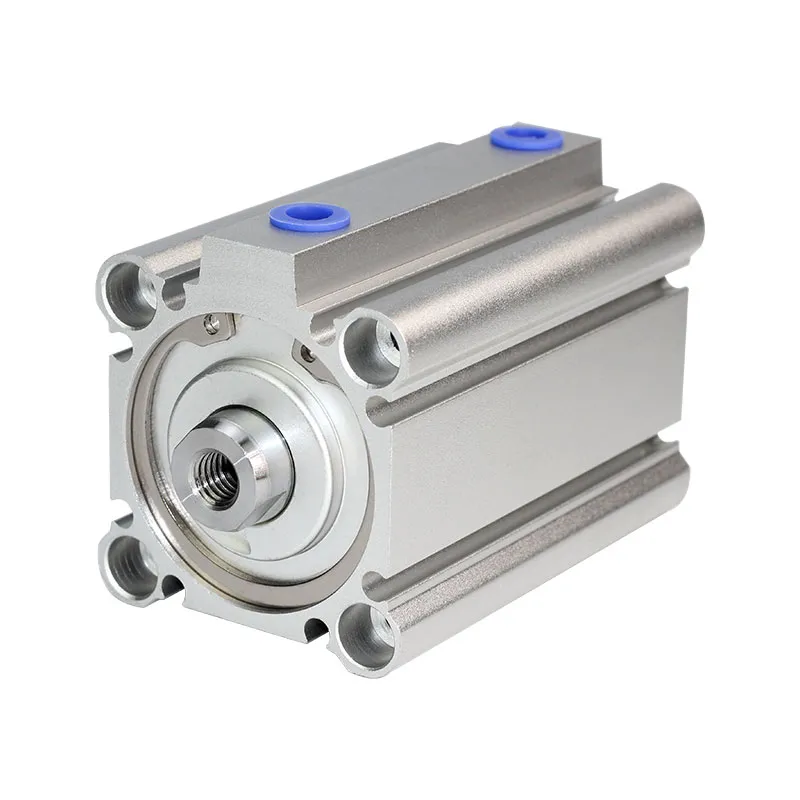
The importance of choosing the right mini cylinder
Choosing the right mini cylinder is essential to ensure efficient operation of machinery and automation systems. The correct choice can not only improve the performance of the system, but also extend the service life of the equipment and reduce maintenance costs.
The following points highlight the importance of choosing the right mini cylinder:
- Improve efficiency: The right mini-cylinder can ensure the accuracy and repeatability of mechanical movements, thereby improving the efficiency of the entire system. Appropriate size and force output ensure that the machinery consumes the least energy during operation and achieves efficient energy conversion.
- Ensure compatibility: Mini cylinders must be compatible with other components in the system to ensure smooth operation of the entire system. Improper selection may result in device failure or performance degradation, affecting the overall reliability of the system.
- Extended Equipment Life: Using a matched mini cylinder reduces mechanical wear and tear, extending the life of your equipment. The correct cylinder operates at the proper pressure and speed, avoiding overloading and potential equipment damage.
- Reduced maintenance costs: The right mini cylinder can reduce failure rates and reduce the need for maintenance and repairs. This not only saves maintenance costs but also reduces production downtime due to repairs.
- Adapt to specific application requirements: Different application scenarios have different requirements for cylinders, including but not limited to load, speed, working environment, etc. Choosing a mini cylinder suitable for a specific application ensures optimal performance of the equipment under specific conditions.
Basic parameters and characteristics of mini cylinder
In order to gain a deeper understanding of the basic parameters and characteristics of mini cylinders, let us explore each element in detail and its importance in the selection process.
1. Dimensions and travel
- Diameter: The diameter of a mini cylinder is directly related to its output force. Under the same pressure, the larger the diameter, the greater the power the cylinder can provide. Diameter selection should be based on the maximum strength required, taking into account space constraints.
- Stroke Length: The stroke is the maximum distance the cylinder piston can move between its ends. The correct stroke length is critical to ensuring that the cylinder completes its intended action. A stroke that is too short may fail to complete the task, while a stroke that is too long may result in reduced system efficiency and wasted space.
2. Work pressure
- Maximum working pressure: The mini cylinder must be designed to withstand the maximum working pressure of the system, which is usually expressed in bar (bar) or pascal (Pa). When selecting, ensure that the rated pressure of the cylinder is higher than the maximum working pressure of the system to prevent damage due to overpressure.
3. Speed
- Speed of movement: The speed at which a piston moves is a critical parameter for many applications. It is affected by factors such as air source pressure, cylinder diameter, load size and cylinder internal design. High-speed motion is particularly important for improving production efficiency, but it is also necessary to consider that excessive speed may have a negative impact on the stability and durability of the system.
4. Load capacity
- Output force: The output force of the mini cylinder determines the maximum load it can drive. This force is calculated as the product of the cylinder internal pressure and the piston area. Proper force output is critical to ensuring that the cylinder can effectively complete its task.
5. Material
- Cylinder material: When choosing a cylinder material, consider its strength, weight, corrosion resistance and cost. For example, stainless steel cylinders are more corrosion-resistant but more expensive, while aluminum alloy cylinders are lightweight but may not be suitable for extreme environments.
6. Durability and Maintenance
- Durability: Considering the cost of replacing cylinders and possible production interruptions, choosing cylinders with high durability can significantly reduce long-term operating costs.
- Maintenance requirements: Some cylinder designs facilitate regular maintenance and component replacement, helping to extend the overall life of the equipment.
7. Installation method
- Fixing method: The way the cylinder is installed is very important to ensure that it works correctly and stably. Different fixing methods are suitable for different applications and space layouts, and the correct choice can simplify the installation process and subsequent maintenance.
8. Working environment
- Environmental conditions: Cylinder selection should also consider the special requirements of the working environment, such as temperature range, humidity, chemical exposure, etc. Specific materials and sealing technologies can improve the performance and life of cylinders in harsh environments.
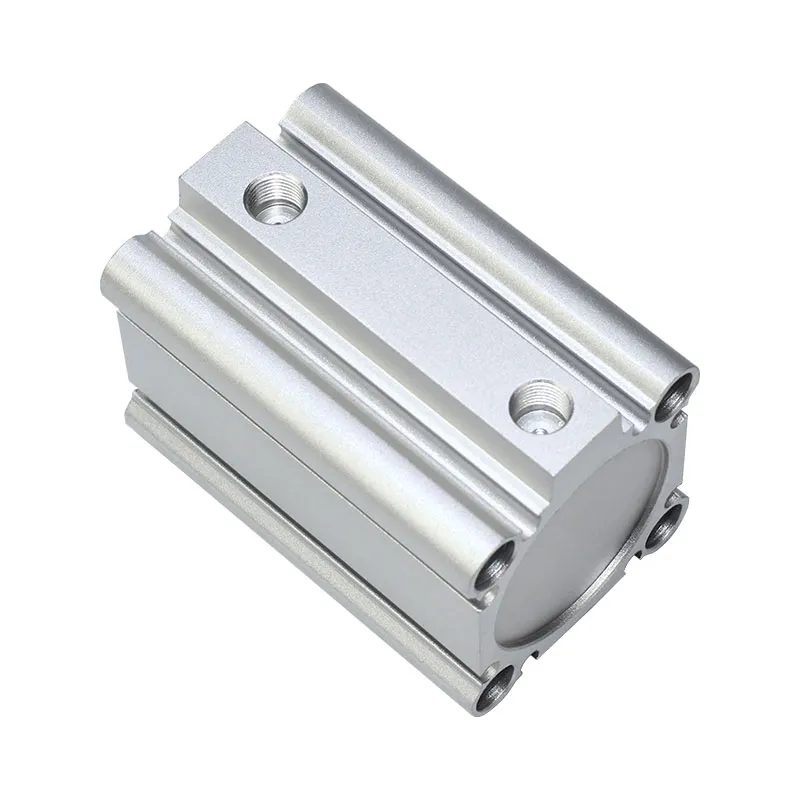
Mini Cylinder Materials and Durability
The material selection of the mini cylinder and its durability are key factors in determining its performance and range of applications. Proper materials can increase a cylinder’s efficiency, extend its service life, and reduce the need for maintenance, thereby lowering the total cost of ownership. Below is a detailed discussion of mini cylinder material selection and durability.
material selection
1. Cylinder block and piston rod materials
- Aluminum alloy: Aluminum alloy is a common material used in the construction of mini cylinder blocks due to its lightweight, high strength and cost-effective properties. It is suitable for most standard applications, especially those where weight is critical.
- Stainless steel: Provides better corrosion and chemical resistance and is suitable for applications in harsh environments or with strict hygiene requirements, such as the food processing and pharmaceutical industries. Stainless steel cylinders are more durable, but the cost is relatively high.
- Carbon Steel: Carbon steel is a reliable choice for applications that require extra strength and durability. Its corrosion resistance can be increased through surface treatment such as chromium plating.
2. Seal and gasket materials
- Nitrile butadiene rubber (NBR): has good oil resistance and is suitable for most applications at room temperature.
- Fluorine rubber (FKM): Provides excellent heat resistance, oil resistance and chemical resistance, and is suitable for high temperatures and harsh chemical environments.
- Polyurethane (PU): Excellent wear and tear resistance, suitable for high load and high wear applications.
Durability considerations
1. Environmental adaptability
- Corrosion resistance: In environments with corrosive substances (such as salt water, acids or alkalis), it is crucial to choose materials with high corrosion resistance (such as stainless steel).
- Temperature resistance: Appropriate materials and seals should be selected according to the temperature range of the working environment to ensure that the cylinder can maintain good performance under extreme temperatures.
2. Mechanical strength and wear resistance
- Mechanical Strength: Choosing materials that can withstand the mechanical loads expected in the application avoids deformation or damage due to overloading.
- Wear resistance: The wear resistance of the piston rod and seals in particular is critical to maintaining the long-term performance of the cylinder and reducing leakage.
3. Maintenance and lifespan
- Ease of maintenance: Material selection should also take into account ease of maintenance. For example, some materials may require special cleaning and maintenance procedures.
- Life expectancy: Durable materials cost more initially, but can result in less frequent replacement over the long term, providing a better return on investment.
Installation and maintenance requirements
When selecting a mini cylinder, considering its installation and maintenance requirements is key to ensuring long-term stable operation and reducing maintenance costs. Proper mounting not only improves cylinder performance and reliability, it also simplifies maintenance and avoids future complications. The following is a detailed discussion of mini cylinder installation and maintenance requirements:
Installation requirements
1. Installation space
- Space configuration: Consider the size and installation space of the cylinder at the early stage of design to ensure there is enough space for installation and future maintenance work. Consider leaving enough space around the cylinder to facilitate inspection and replacement.
- Installation location: The cylinder should be installed in a location that ensures that it can function properly without interference from surrounding environmental factors, such as direct exposure to extreme temperatures, humidity, or corrosive chemicals.
2. Installation method
- Fixing method: Select the appropriate fixing method according to the specific needs of the application, including flange installation, foot installation, trunnion installation, etc. Different fixing methods affect the stability and stress distribution of the cylinder.
- Alignment: Ensure that the cylinder is well aligned with the drive components when installed to avoid additional load and wear caused by improper installation angle or position.
Maintenance requirements
1. Maintenance convenience
- Accessibility: Cylinders should be installed with ease of long-term maintenance in mind, ensuring easy access for regular inspection, cleaning and component replacement.
- Modular Design: Choosing a cylinder with a modular design makes it easier to replace parts during maintenance without disassembling the entire system.
2. Regular inspection and maintenance
- Inspection plan: Develop a plan for regular inspections, including checking the sealing performance of the cylinder, the wear of the piston rod and cylinder block, and the tightness of the connecting parts.
- Cleaning and Lubrication: Regularly clean the cylinder and piston rod to remove accumulated dirt and dust, and lubricate seals and piston rods according to manufacturer’s recommendations to keep the cylinder in good working order.
3. Fault diagnosis and repair
- Fault diagnosis: Train maintenance personnel to identify and diagnose common cylinder problems, such as cylinder leakage, abnormal noise or uneven movement.
- Rapid response and repair: Ensure maintenance teams can quickly respond and fix issues, reducing downtime. Keep frequently used spare parts in stock to quickly replace damaged parts.

Cost-benefit analysis
Cost-benefit analysis of mini cylinders involves considering initial investment, operating costs, maintenance expenses and ultimately price/performance. When selecting a mini cylinder, understanding its cost-effectiveness is critical to ensuring economic efficiency and achieving long-term return on investment. Below is a detailed discussion of mini cylinder cost-benefit analysis:
Initial investment
- Purchase cost: The purchase price of the mini cylinder directly affects the initial investment cost. Price is affected by factors such as the size, material, manufacturer and technical complexity of the cylinder. While choosing a lower-cost cylinder reduces the initial investment, performance and durability may be sacrificed.
- Installation cost: includes the cost of cylinder installation and system commissioning. Choosing a cylinder that is easy to install and debug can reduce this cost.
Operating costs
- Energy Consumption: A major component of operating costs is energy consumption. Efficient mini cylinders require less energy during use, especially in mass production environments, where reduced energy consumption can significantly reduce operating costs.
- Production efficiency: The performance of the mini cylinder directly affects the efficiency of the production line. High-efficiency cylinders can increase production speed and quality, thereby indirectly reducing the production cost per unit product.
Maintenance costs
- Regular maintenance: includes the cost of cleaning, lubricating and replacing worn parts. Choosing a cylinder that is easy to maintain can reduce this expense.
- Unplanned Maintenance and Breakdown Repair: Unexpected failures can lead to costly maintenance costs and lost production downtime. Although the initial investment of a highly durable mini cylinder is higher, it can reduce the frequency of breakdowns and maintenance costs in the long run.
Cost-effectiveness
- Total Cost of Ownership (TCO): When evaluating the cost-effectiveness of a mini cylinder, the total cost over its entire life cycle should be considered, including initial investment, operating costs and maintenance expenses.
- Return on Investment (ROI): Cost-effective mini cylinders are not only reasonably priced at the time of purchase, but also offer low operating and maintenance costs over the entire life cycle, resulting in a faster return on investment.
Applications of mini cylinders in different fields
The application solutions of mini cylinders in various fields reflect their flexibility and efficiency. They can not only adapt to compact space requirements, but also provide precise power control. Below are some mini cylinder application solutions in different areas, showing how they solve specific technical challenges.
1. Automated manufacturing
- Challenge: The production line needs to be highly automated to improve production efficiency and product quality while reducing manual errors.
- Application: Mini cylinders are used in automated assembly lines for fast and accurate component handling, positioning and assembly. Their compact size enables the deployment of multiple operating units in limited spaces, while high repeatability ensures consistent product quality.
2.Mechanical design
- Challenge: Mechanical devices, such as robotic arms and precision machining equipment, need to be able to perform complex sequences of movements while maintaining high accuracy and repeatability.
- Application: Mini cylinders provide power in the joints and moving parts of robotic arms for precise control. Their response speed is fast and they can be positioned quickly and accurately in precision operations, which enhances the flexibility and operating accuracy of the equipment.
3.Medical equipment
- Challenge: Medical laboratories handle large volumes of biological samples, which requires equipment that can operate precisely, avoid contamination, and process samples quickly.
- Application: Mini cylinders control sample handling, distribution and analysis processes in automated medical analysis equipment. Their precise control reduces the risk of cross-contamination and increases the efficiency and accuracy of sample processing.
4. Packaging industry
- Challenge: Packaging processes need to handle products quickly and continuously while maintaining packaging quality and reducing material waste.
- Application: Mini cylinders enable rapid product positioning, handling and packaging in packaging machinery. They can adapt to the packaging needs of different products and provide continuous and consistent operation, thus optimizing the packaging process and reducing downtime and material waste.
5.Entertainment and exhibitions
- Challenge: Exhibitions and entertainment facilities need to create vivid, engaging visuals to enhance audience engagement and experience.
- Applications: Mini cylinders provide subtle motion control in animated characters in exhibition installations and theme parks. Their compact design and precise control enable complex action simulations, such as simulating character breathing, smiling and other dynamic effects, providing a more realistic and vivid experience for the audience.

Conclusion
When selecting a mini cylinder, it is critical to thoroughly evaluate and understand the application needs and operating environment. The following summarizes the key points to consider when choosing a mini cylinder:
- Application requirements: Make sure you have a clear understanding of your application’s specific requirements for accuracy, repeatability, load capacity, speed and response time.
- Size and Stroke: Select cylinder size and stroke length that meets installation space constraints and operating requirements.
- Working environment: Consider the environment in which the cylinder will work, including temperature, humidity, potential corrosion factors, etc., to ensure that the selected cylinder can adapt to these conditions.
- Materials and Durability: Depending on the work environment and application requirements, choose the appropriate cylinder material to ensure durability and long-term performance.
- Installation and Maintenance: Consider designs that are easy to install and maintain to reduce long-term operating and maintenance costs.
- Cost-benefit analysis: Conduct a comprehensive cost-benefit analysis that considers initial purchase cost, operating and maintenance expenses, and expected service life to ensure the selected cylinder provides the best overall value.
- Technical support and service: Choose a supplier that provides good technical support and customer service to ensure that you can get the necessary help and guidance during use.
By taking the above factors into consideration, you will be able to select the mini cylinder that best suits your specific application, ensuring efficient operation of the system and maximizing cost performance. The proper selection process involves a deep understanding of the application requirements and careful evaluation of various performance parameters with the goal of ensuring that the selected cylinder will provide optimal performance and durability in a given operating environment.




